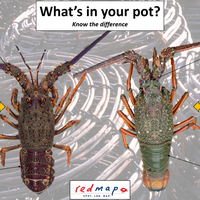What's in your pot? Know the difference!
Tyson Jones, 27 Jun 2023.
Eastern Rock Lobster (Sagmariasus verreauxi) are on the move! Do you know how to tell them apart from the common Southern Rock Lobster (Jasus edwardsii)? Help Redmap Australia track the southern expansion of this species by logging it if you spot one in Tasmania or South Australia!
The opening of the Lobster season remains a highly anticipated date for fishers in Australia’s southern states. Whether it’s dropping a set of pots or pulling on a wetsuit, Lobster have been a highly valued catch off Australia’s coastline for millennia.
In the southern waters of Australia, the Southern Rock Lobster (Jasus edwardsii) has been the primary focus of these fishing efforts. However, as the ocean progressively warms, and the Eastern Australia Current continues to provide a conveyor belt of warm water to the south, other species of Lobster are starting to pop up in areas, not historically recorded before.
The Eastern Rock Lobster (Sagmariasus verreauxi) is one species making the most of this warming water, with individuals being recorded much further south than their historical southern range. Consequently, these larger bodied species (the biggest of their kind!) are being caught more frequently alongside their southern relatives.
To aid in monitoring this southern expansion, Redmap Australia is putting the call out to Australian fishers to document their catch, particularly if they see any Eastern Rock Lobsters in Tasmania or across the South Australian border.
What to do:
Log it when found in Tasmania or South Australia!
What to look out for:
Habitat: Rocky reefs
Depth: 0 – 150m
Size: Up to ~25cm carapace length, ~60cm total length – The largest species of its kind!
Colour: Green/Brown/Red with Orange/Brown legs
Defining features:
Eastern Rock Lobster: Short rostral project between eyes/horns with smooth abdominal segments
Southern Rock Lobster: Two large horns above eyes with NO central rostral projection and roughly patterned abdominal segments.












